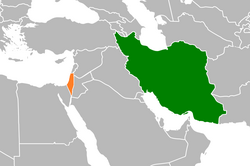Iran–Israel relations
 |
|
|
Iran |
Israel |
|---|---|
Iranian–Israeli relations can be divided into four major phases: the period from 1947–53, the friendly period during the era of the Pahlavi dynasty, the worsening period from the 1979 Iranian Revolution to 1990, and finally the hostility since the end of the First Gulf War. In 1947, Iran was among 13 countries that voted against the UN Partition Plan for Palestine. Two years later, Iran also voted against Israel's admission to the United Nations. Nevertheless, Iran was the second Muslim-majority country to recognize Israel as a sovereign state after Turkey. After the 1953 coup d'état, which brought pro-Western Mohammad Reza Pahlavi to power, relations between the two countries significantly improved. After the 1979 Revolution, Iran severed all diplomatic and commercial ties with Israel, and its Islamic government does not recognize the legitimacy of Israel as a state.
The turning point from cold peace toward hostility occurred in the early 1990s, shortly after the collapse of the Soviet Union and defeat of the Iraqi Army during Desert Storm, after which distribution of relative power shifted towards Iran and Israel and formed a nascent bipolar structure in the Middle East. The conflict escalated in the early 1990s, as Yitzhak Rabin's government adopted a more aggressive posture on Iran.Rhetorical conflict additionally heated up during the presidency of Mahmoud Ahmadinejad, who made inflammatory statements against Israel. Other factors which have contributed to the escalation of tensions include Iran's development of nuclear technology relative to Israel's long-stated Begin Doctrine, Iranian funding of groups like Hezbollah, Islamic Jihad and Hamas, and alleged involvement in terrorist attacks such as the 1992 attack on Israeli embassy in Buenos Aires and the 1994 AMIA bombing, alleged Israeli support for groups like PMOI or Jundallah and alleged covert operations in Iran including assassinations and explosions.
...
Wikipedia
